On a back country road in northern NSW, up a nondescript dirt driveway, sits a highly secret facility.
Surrounded by strict security, thousands of cannabis plants are being carefully cultivated in state-of-the-art greenhouses for the medicinal cannabis market.
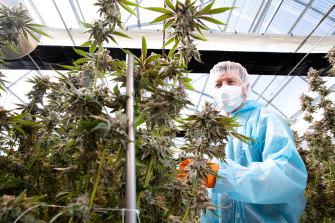
The Australian Natural Therapeutic Group facility, near Armidale, is about to start producing medicinal cannabis oil on a commercial scale – the first such manufacturing licence granted in the state.
The company’s chief executive Matthew Cantelo said he had noticed quite a large increase of approvals under the Special Access Scheme, as well as a rise in the number of authorised prescribers.
“[That] tells us that doctors are having more confidence in the safety and efficacy of the products,” he said.
“Also, the research is catching up.”
Professor Iain McGregor, from the Lambert Initiative for Cannabinoid Therapeutics at the University of Sydney, said there was “increasingly good evidence” that cannabis was effective.
“It helps people get off more sinister drugs, particularly prescription opioids and Lyrica-type drugs as well, which can be very problematic,” he said.
Cannabis has two main chemical components. THC is the psychoactive ingredient, responsible for giving people the “high” feeling. Cannabidiol, or CBD, does not have the same psychoactive effect. Both are used in different levels as treatments for various conditions.
Budding business
Medicinal cannabis might not be a common household drug, but it’s a growing business in Australia.
Since 1992, 61,000 approvals for medicinal cannabis had been granted by the Therapeutic Goods Administration through the Special Access Scheme, but most of these have occurred in the past few years.
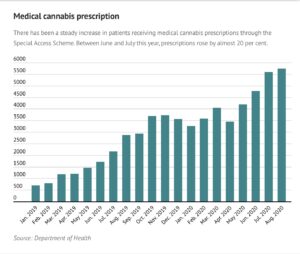
Since August last year approvals have doubled, from 2878 to 5739. Between June and July this year alone, approvals rose by 20 per cent.
There have been some big changes in the past four years that have helped improve access, including the introduction of medicinal cannabis clinics, improved information for prescribers and a drop in product price.
Professor McGregor said that today, medicinal cannabis costs roughly 25 per cent of what it did in 2017, or about $5 to $15 per day per patient.
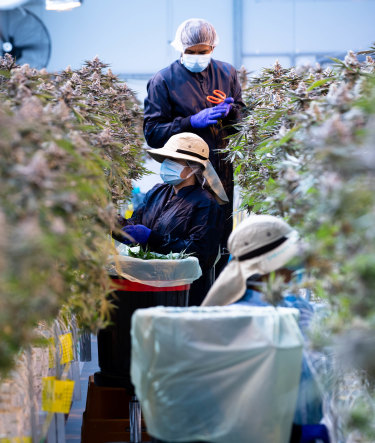
The price drop has been aided by the sheer number of products now available on the Australian market, with about 150 different medicinal flower and oil products being sold by 37 companies, which are fighting for a small number of patients.
“We used to joke that there was one patient for every company in this space in Australia,” Professor McGregor said.
The TGA has also recently released an interim decision to downgrade certain medicinal cannabis products from Schedule 4 to Schedule 3, which would allow approved low-dose products to be sold over the counter at the pharmacy.
But that decision is not final and Mr Cantelo, who started building the medicinal cannabis company in earnest about five years ago, is playing the long game.
At the moment just one-quarter of their flower produce is sold to Australian patients while the rest is exported.
Production is starting on its first commercial oil product, and he said there would be four of those in coming months.
“We’ve got four products on the market to Australian patients right now ranging from a high CBD, very low THC product right up through to a very high THC, low CBD product and two in the middle,” he said.
Medicinal cannabis not a panacea
Most approvals were for chronic pain, a TGA spokesman said. Medicinal cannabis has also been approved for cancer pain and fibromyalgia, for managing seizures or epilepsy, to treat psychological conditions including anxiety, anorexia, insomnia or post-traumatic stress disorder, and for multiple sclerosis and other movement disorders.
While the TGA spokesman said the number of approvals fluctuated from month to month, more doctors were now prescribing it.
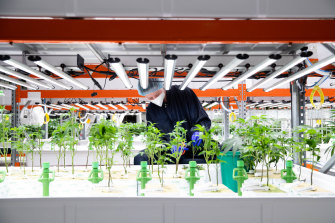
Last year 1298 individual prescribers sent Special Access Scheme applications to the TGA. This year to date, the TGA has received applications from 1827 individuals; a 41 per cent increase.
Royal Australian College of General Practitioners spokeswoman Hester Wilson said applications were increasing in part because of medicinal cannabis clinics, but GPs were increasingly seeing it as an option for longstanding patients on a case-by-case basis.
“We do need to increase the evidence around when medicinal cannabis is appropriate; and that’s really not clear,” she said.
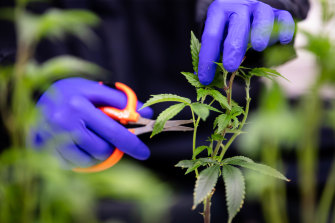
“But it is one of those situations where sometimes for us, as individual prescribers who know our patients well, that it absolutely is a choice that we can and do make in order to assist the individual patients that we’re seeing.”
Dr Wilson, who is also an addiction specialist, said it would only be something she would prescribe if she had been having an extended conversation about it with a patient she knew well and they were both clear about the expected outcome.
“They do need to be aware of the risks and the fact that we don’t know what the benefits are,” she said. “So I really do take a very cautious approach.”
Professor McGregor, who recently co-authored a paper comparing medicinal cannabis access around the world, said while there had been almost exponential growth in medicinal cannabis use, Australia had a long way to go.
Professor McGregor said the federal government’s own statistics from the Australian Institute of Health and Welfare estimated there were 600,000 people who were self-medicating with cannabis from the black market.
“[With] a liberal estimate of maybe 30,000 patients being serviced by the official scheme, then you’ve still got 570,000 that are unaccounted for,” he said.
“I don’t think we should be slapping ourselves on the back too firmly at this stage, we’ve still a long way to go. But the trends are certainly a lot more positive than they were.”
